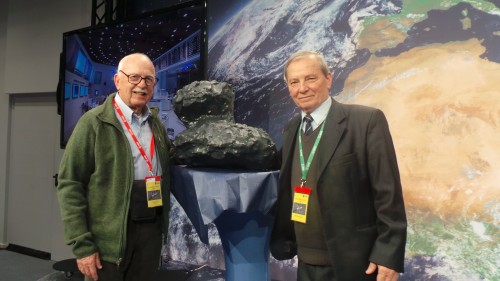The Rosetta spacecraft orbiting the comet 67P Churyumov-Grasmankato discovered that there was an increase in the amount of water leaking from the comet, when the Philae lander landed on its surface in November 2014

The comet, which is about 4 km wide, ejected an amount equivalent to about 1.2 liters of water into space every second in August 2014. The observation was made by NASA's MIRO measuring instrument operating in the microwave field, located on the European Rosetta spacecraft. The studies based on data from MIRO were published this weekend as part of a special edition of the journal SCIENCE dedicated to Rosetta.
"In the observations conducted over three months (June-August 2014), the amount of water evaporating into space increased many times over," says Sam Golkis, the principal investigator of MIRO at NASA's Jet Propulsion Laboratory (JPL) in California, and the principal investigator of the article appearing in the special issue. "The fact that we were so close to the comet for such a long period of time gave us an unprecedented opportunity to see how comets turn from cold, icy bodies into active objects that emit gas and dust as they approach the Sun.
The MIRO instrument is a lightweight spectrometer that can map the frequency, temperature and speed of evaporation of cometary water and other molecules from the comet's nucleus. It can also measure temperatures to a depth of 2 centimeters below the surface of the comet nucleus.
One of the reasons for the importance of measuring the temperature below the surface is that such a measurement helps to locate gases originating from subsurface ice heaving. By combining the data about the gas and the surface, the MIRO can study the process in detail.
In addition, in an article published today, the MIRO team reports that the comet spews gas from several points around the nucleus for "a day". As is known, the nucleus of comet 67P consists of two parts, sometimes called "body" and "head" due to its duck-like shape, connected by a kind of neck. A significant part of the emissions measurements in the months of June-September 2014, were from the neck area in the "afternoon" hours.
"It is possible that the situation has changed in the meantime because the comet is heating up" says Golkis. "The MIRO observations will be analyzed in detail to determine which factors, in addition to the sun's heat, are responsible for the gas emissions from the comet.
The researchers continue their observations with the aim of finding a change in the emission rate and the orbit of the comet that cause a change in the gas emission with the change in distance to the sun. This information will help scientists understand how comets evolved as they orbit the sun and move to and from it.
The rate of gas emissions is also important to the Darmstadt control center personnel who navigate Rosetta, because the gas flowing from it may affect the spacecraft's speed and direction.
For information on the NASA website
